Katherine Coleman Johnson Way
Introduction
Text-to-speech Audio
On May 26, 2017, the city of White Sulphur Springs declared this previously unnamed street in honor of NASA mathematician Katherine Coleman Johnson. Now known as "Katherine Coleman Johnson Way," this street the leads to the city library honors the life of the mathematician from White Sulphur Springs whose contributions to the American space program were highlighted in the movie "Hidden Figures." Katherine Coleman was born in White Sulphur Springs and demonstrated an incredible aptitude for math. Johnson quickly earned a degree in mathematics from West Virginia State University and became one of the first three African American graduate students to be admitted to West Virginia University in 1939. Her work for NASA in the 1950s played a critical role in the calculations needed to place spacecraft into orbit, and later, on the Moon. Johnson was awarded many honors for her work, including the Presidential Medal of Freedom, and in 2016, the film "Hidden Figures" detailed her contributions to NASA.
Images
Street dedication ceremony, May 26, 2017
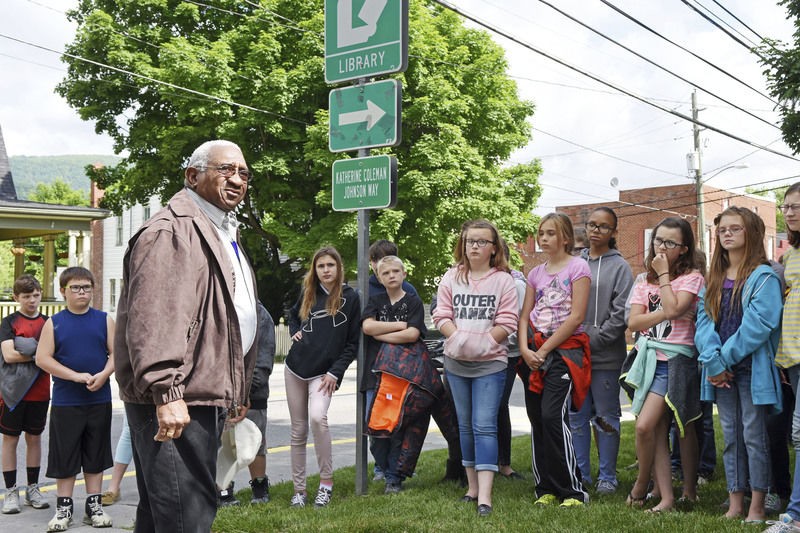
Katherine Coleman Johnson
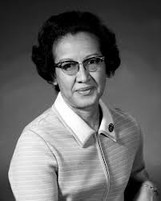
Katherine Coleman Johnson at work
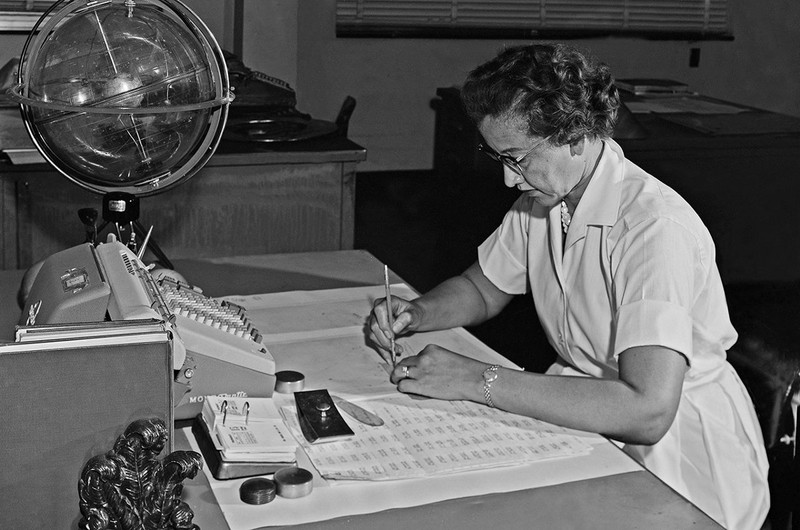
Katherine Coleman Johnson receiving the Presidential Medal of Freedom from President Obama
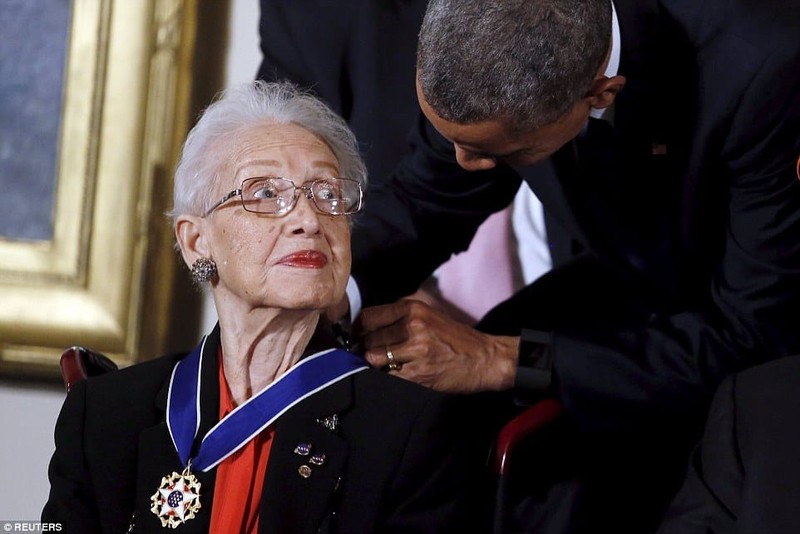
Katherine Coleman Johnson (left), and the actress who portrayed her in the 2016 major motion picture "Hidden Figures", Taraji P. Henson (right).
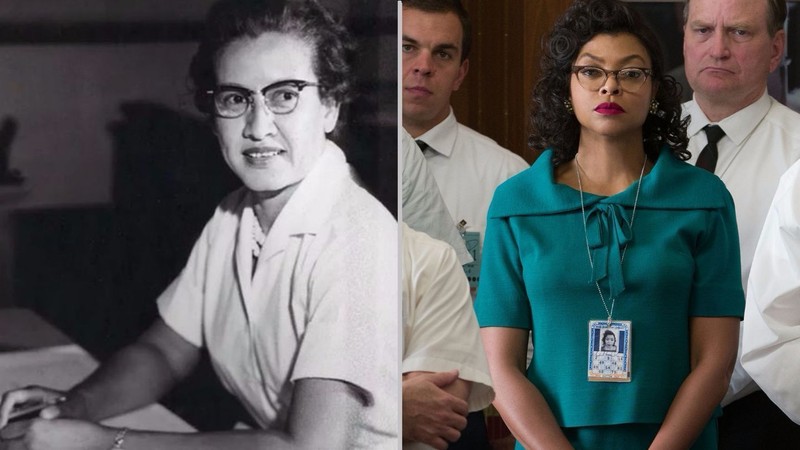
Backstory and Context
Text-to-speech Audio
Katherine Coleman Johnson was born in the town of White Sulphur Springs on August 26, 1918. From a young age, her parents noticed that young Katherine was gifted in mathematics. After finishing high school at 15, Johnson attended college classes at the historically Black West Virginia State College, where she double-majored in Mathematics and French. She completed both bachelors degrees at the age of 18.
Johnson was chosen as one of the first three African American students to attend West Virginia University when West Virginia integrated its graduate schools in 1939, making history in the Civil Rights movement. She was the first Black female to attend West Virginia University, where she pursued a graduate degree in mathematics. Johnson found West Virginia University more hostile than West Virginia State College. She learned of a job opening at the National Advisory Committee for Aeronautics in an all-Black section, where she began working in 1953.
Johnson's incredible math skills and her work on flight test data was needed several years later as NASA undertook the task of putting astronaut John Glenn into orbit. Glenn himself told the team to "get the girl" to hand-check the equations the computers had worked out just prior to his launch into orbit.2 The computers that had been used to calculate the math needed to send spacecraft into orbit were still in infancy stages, and were erratic at times. Johnson's accuracy was often called upon to identify and prevent malfunctions. Her work helped make the 1969 Apollo 11 moon landing a success, and she was part of the team responsible for safely returning the Apollo 13 spacecraft when it malfunctioned in space.
Johnson's long list of achievements led her to receive a number of honors, including the Presidential Medal of Freedom in 2015. NASA awarded her with the Lunar Orbiter Award, three NASA Special Achievement Awards, and she was chosen as Mathematician of the Year in 1997. As stated by NASA Administrator Charles Bolden, "Katherine's legacy is a big part of the reason that my fellow astronauts and I were able to get to space; it's also a big part of the reason that today there is space for women and African-Americans in the leadership of our nation, including the White House."
As of May 26th, 2017, the street between the White Sulphur Springs Public Library and the St. Thomas Episcopal Church is named Katherine Coleman Johnson Way. The street was selected because Johnson's father worked at the city library in its previous location, and because the library was an important part of the future mathematician's life.
Johnson lived on Church Street in White Sulphur Springs until she was 10 years old. Mayor Lloyd Haynes called Johnson "one of the best-kept secrets ever," as Johnson's contributions to NASA, mathematics, women's rights, and the Civil Rights Movement were widely unknown until the release of the book and film "Hidden Figures."
The small ceremony commemorating the dedication of Katherine Coleman Johnson capped off a series of honors following the public's growing interest in her life following the popularity of the Hollywood film "Hidden Figures." The state of West Virginia now celebrates the 26th of August as Katherine Johnson Day.
Johnson was chosen as one of the first three African American students to attend West Virginia University when West Virginia integrated its graduate schools in 1939, making history in the Civil Rights movement. She was the first Black female to attend West Virginia University, where she pursued a graduate degree in mathematics. Johnson found West Virginia University more hostile than West Virginia State College. She learned of a job opening at the National Advisory Committee for Aeronautics in an all-Black section, where she began working in 1953.
Johnson's incredible math skills and her work on flight test data was needed several years later as NASA undertook the task of putting astronaut John Glenn into orbit. Glenn himself told the team to "get the girl" to hand-check the equations the computers had worked out just prior to his launch into orbit.2 The computers that had been used to calculate the math needed to send spacecraft into orbit were still in infancy stages, and were erratic at times. Johnson's accuracy was often called upon to identify and prevent malfunctions. Her work helped make the 1969 Apollo 11 moon landing a success, and she was part of the team responsible for safely returning the Apollo 13 spacecraft when it malfunctioned in space.
Johnson's long list of achievements led her to receive a number of honors, including the Presidential Medal of Freedom in 2015. NASA awarded her with the Lunar Orbiter Award, three NASA Special Achievement Awards, and she was chosen as Mathematician of the Year in 1997. As stated by NASA Administrator Charles Bolden, "Katherine's legacy is a big part of the reason that my fellow astronauts and I were able to get to space; it's also a big part of the reason that today there is space for women and African-Americans in the leadership of our nation, including the White House."
As of May 26th, 2017, the street between the White Sulphur Springs Public Library and the St. Thomas Episcopal Church is named Katherine Coleman Johnson Way. The street was selected because Johnson's father worked at the city library in its previous location, and because the library was an important part of the future mathematician's life.
Johnson lived on Church Street in White Sulphur Springs until she was 10 years old. Mayor Lloyd Haynes called Johnson "one of the best-kept secrets ever," as Johnson's contributions to NASA, mathematics, women's rights, and the Civil Rights Movement were widely unknown until the release of the book and film "Hidden Figures."
The small ceremony commemorating the dedication of Katherine Coleman Johnson capped off a series of honors following the public's growing interest in her life following the popularity of the Hollywood film "Hidden Figures." The state of West Virginia now celebrates the 26th of August as Katherine Johnson Day.
Sources
1. "Spa City Lane named for Katherine Coleman Johnson," accessed July 20, 2017, http://www.register-herald.com/news/spa-city-lane-named-for-katherine-coleman-johnson/article_677a2d...
2. "Katherine Johnson Biography," accessed July 23, 2017, https://www.nasa.gov/content/katherine-johnson-biography
3. "Katherine G. Johnson," accessed July 23, 2017, https://www.biography.com/people/katherine-g-johnson-101016
4. "State Launches Career of Pioneering NASA Mathematician Katherine Johnson," accessed July 23, 2017, http://www.wvstateu.edu/About/History-and-Traditions/Katherine-Johnson.aspx
5. "Dedication ceremony set for Katherine Coleman Johnson Way," accessed July 27, 2017, http://www.register-herald.com/news/dedication-ceremony-set-for-katherine-coleman-johnson-way/articl...
2. "Katherine Johnson Biography," accessed July 23, 2017, https://www.nasa.gov/content/katherine-johnson-biography
3. "Katherine G. Johnson," accessed July 23, 2017, https://www.biography.com/people/katherine-g-johnson-101016
4. "State Launches Career of Pioneering NASA Mathematician Katherine Johnson," accessed July 23, 2017, http://www.wvstateu.edu/About/History-and-Traditions/Katherine-Johnson.aspx
5. "Dedication ceremony set for Katherine Coleman Johnson Way," accessed July 27, 2017, http://www.register-herald.com/news/dedication-ceremony-set-for-katherine-coleman-johnson-way/articl...
